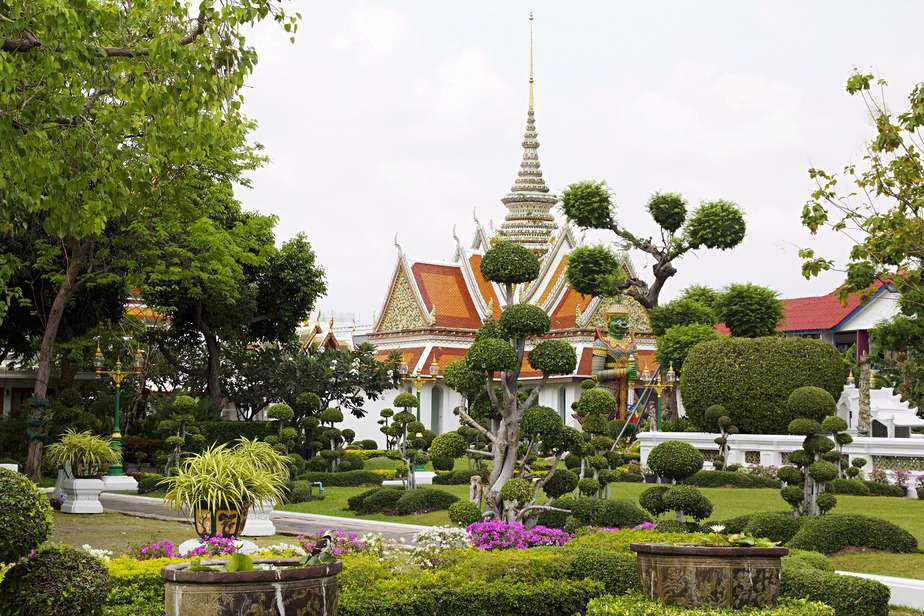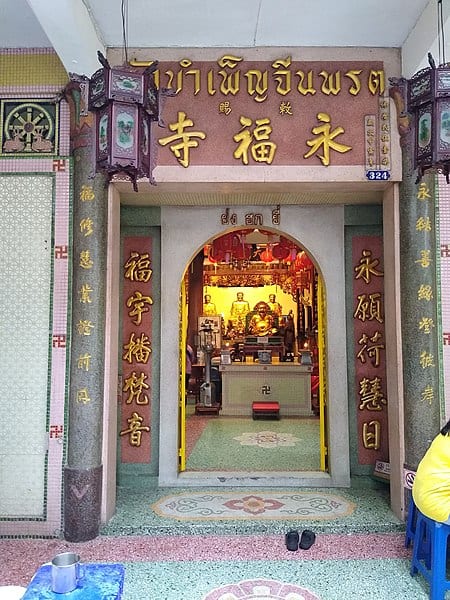A Brief Guide to Non-Thai Temples and Shrines in Bangkok
Posted by Mark Philip
These days, pretty much everyone who has ever been to Bangkok will have been on some form of ‘temple tour’, whether through a local operator or under their own steam, so to speak.
And there can be no denying that the beauty of these temples, along with their historical and cultural value to the Thai nation is of high regard for both locals and visitors.
However, what many visitors to the Thai capital may not always realise is that there is a very wide variety of other temples, churches and shrines related to other cultures and religions that have either settled and integrated into the Thai populace at some time in the past, or have merely left their mark in some way.
The most notable examples here would likely be the Chinese and Indian immigrants who have long since integrated into the capital, and indeed the nation’s population, usually most obviously in specific areas of the country of the capital.
Bangkok comprises both Chinese and Indian sectors (Chinatown and Little India) as well as an ‘Arab Quarter’ along one of the main stretches of the Sukhumvit Road area. What many people may not be aware of though is the large Muslim population in the city, along with various other non-Thai ethnicities such as the Vietnamese.
So with that in mind it is no surprise to find, hidden among Bangkok’s skyscrapers and shopping malls, plenty of Chinese, Vietnamese, Indian, and other variations on temples and shrines other than the ‘Thai’ versions (which are largely a mix of different styles and influences anyway), along with mosques and Christian churches. (Check out one of our previous features on Bangkok’s churches for more information about that particular aspect.)
Whether you consider yourself part of any particular religious or spiritual designation or otherwise, you are still likely to find not only the Thai temples impressive places, but many of these other ancient relics and slightly more modern buildings are also architectural wonders in their own right, as well as providing places of worship to Bangkok visitors of various other denominations.
The Chinese temples in particular were formerly hubs of activity for the ever-increasing hordes of new Chinese settlers to Thailand over the years. Today, they are largely still surrounded by markets, food stalls and other places to find various goods. A visit t many of these places provides a glimpse into Bangkok’s rich history.
So while this post is by no means exhaustive – in fact it is probably only the tip of the iceberg – here we have an interesting mix of places that encompass various ethnicities, cultures and religions that all add to the unique melting pot known as Bangkok.
1. Wat Mangkon Kamalawat
This Bangkok Chinese temple, which is also known as Wat Leng Noei Yi, is a located right in the heart of Chinatown. This is an active temple which still serves as the hub of local community activities.
The temple comprises a few impressive Buddhist, Taoist and Confucian shrines, and apparently it harks back back to 1872 when it was called Wat Leng Nui Yee. Its name was later changed to Wat Mangkon Kamalawat (which means Dragon Lotus Temple).
The activities that occur in the temple are at their most prominent throughout festival periods such as Chinese New Year, and this particular Chinese temple in Bangkok is often considered as one of the city’s most largest and most prominent Chinese-Buddhist temples.
Location: 423 Charoen Krung Rd, Pom Prap, Pom Prap Sattru Phai, Bangkok 10100
Open: Daily from 9 am to 5 pm
Phone: +66 (0)2 222 3975
2. Guan Yu Shrine
Staying with the Chinese theme for a few moments longer, if we head along the Chao Phraya River from Klong San Pier on the Thonburi side of the city, we can find a shrine dedicated to an ancient god of war renowned for his courage and honesty.
Bangkok, with its large and established Chinese community, is home to several shrines to Guan Yu, but this particular example is the most ancient, dating back as far as 300 years.
It is relatively easy to spot the three-story pagoda of the shrine with its coiled dragons around the pillars from a ferry on the Chao Phraya.
The shrine actually comprises two small images of Guan Yu, who is recognisable from his red face and long beard, and inside there are also images of other popular Chinese deities such as Kuan Yin (goddess of compassion), Mi-Lo-Fo (the laughing Buddha) and Amitabha (the future Buddha).
Worth a look by anyone remotely interested in Chinese culture and architecture.
Location: 252 Somdet Chao Phraya Rd.
Open daily 7am–6pm
3. Leng Buai Ia Shrine
Here stands another Chinese shrine that, according to its inscription, was built in 1658, qualifying it as the most ancient in Thailand.
Inside the shrine is an altar for the Chinese deity Leng Buai Ia and his wife, as well as a few others such as the deity Gong Wu, and the Queen of Heaven. Considering the age and hence cultural value of the shrine, it remains discreetly tucked away among the winding and seemingly endless back streets of Chinatown.
Check it out if you are a hardcore devotee of Asian and Chinese lore, artifacts, and designs.
Location: 125 Yaowarat Soi 6, Chinatown, Bangkok.
Open daily 7am-5pm
4. Kahn Vahn Temple (Wat Uphai Ratbamrung)
Stepping away from the strictly Chinese shrines and temples into a variation of the theme, we find a magnificent Vietnamese Mahayana Buddhist temple, again within the districts of Bangkok’s Chinatown.
This is actually a temple that the majority of locals, including those in the Chinatown district, have no idea was established by a monk from Vietnam over 300 years ago.
The temple is actually said to have been built in 1787, and is instantly distinguishable from the typical Thai-style temple by its carved doors which are often mistaken for Chinese in design.
Actually the majority of the local families who form the main congregation of the temple are of distant Vietnamese heritage, with the only link to their ethnicity being this slightly strange temple. The chanting is even done in Vietnamese, but the resident Thai monks need to read the words transliterated into the Thai languange.
Address: Charoen Krung Rd, Talat Noi, Samphanthawong, Bangkok 10100
Phone: (+66) 081 402 5502
5. Wat Bampen Chine Prote (Wat Yong Hok Yi)
Wat Bamphen Chin Phrot or familiarly known in Teochew Yong Hok Yi is a Chinese temple of the Mahāyāna sect in Thailand, located on Soi Yaowarat 8, Samphanthawong Subdistrict, Samphanthawong District, Bangkok.
Address: 324 ซอย Yaowarat 8, Samphanthawong, Bangkok 10100
Hours: 8 AM – 6 PM
Phone: 02 222 4789
6. Gurdwara Sri Guru Singh Sabha
This is a 90-year-old Sikh temple, located in an area called Pahurat, which again is quite close to Bangkok’s Chinatown. This region is in fact the heart of the relatively small Sikh community resident in the city.
The white temple has 6 floors in all, and is topped off with the golden dome familiar to the Sikh tradition. It is said to be the second largest of its kind outside India, and has a large congregation hall on the 4th floor, an international school on the 5th floor and the main prayer area is of course located on the highest floor, where a copy of the Sikh holy book, Sri Guru Granth Sahib, is kept on the flower-filled altar.
Location: 571 Chakkraphet Rd, Wang Burapha Phirom, Phra Nakhon, Bangkok 10200
Open: Daily from 10 am to 6 pm
Phone: +66 (0)2 221 1011
7. Sri Maha Mariamman Temple
A bit closer to what might be considered the main heart of the city in Silom, we can find a Hindu temple dedicated to the Goddess Mariamman. This is a famous Bangkok temple that is even attended by many Thais on occasion, and it was built by Tamil immigrants more than 150 years ago.
The temple is instantly recognisable from its bright Indian architecture with rich colour schemes and ornate decoration that is not exactly a typical-looking aspect of the Silom scenario.
The central structure is quite tall and features intricately-detailed images of entwined Hindu deities. In the inner shrines of the temple some of the familiar Hindu deities such Shiva and the elephant-headed Ganesha can be seen, along with other imagery related to Vishnu and Krishna.
Location: 2 Pan Rd, Silom, Bang Rak, Bangkok 10500, Thailand
Phone: +66 (0)2 238 4007
8. Haroon Mosque
There are many mosques in Bangkok, but this particular gem is not only one of the busiest, but it is also one of the oldest in the city.
You can find the Haroon Mosque located somewhere within a network of small alleyways, quite close to the famous, equally historic Mandarin Oriental Hotel, in what is largely known as the Thai capital’s Riverside area.
Originally he building was a single-floored wooden structure that has since been replaced by brick-coloured concrete after it had virtually crumbled beyond repair due to its age and a lack of maintenance.
Inside the mosque you can find fine and intricately carved Arabic script and designs, and the building is on the large side in that it can accommodate as many as 500 people.
Location: 25 Charoen Krung Rd, Bang Rak, Bangkok 10500
Phone: +66 (0)81 488 8154
Planning a trip to Paris ? Get ready !
These are Amazon’s best-selling travel products that you may need for coming to Paris.
Bookstore
- The best travel book : Rick Steves – Paris 2023 – Learn more here
- Fodor’s Paris 2024 – Learn more here
Travel Gear
- Venture Pal Lightweight Backpack – Learn more here
- Samsonite Winfield 2 28″ Luggage – Learn more here
- Swig Savvy’s Stainless Steel Insulated Water Bottle – Learn more here
Check Amazon’s best-seller list for the most popular travel accessories. We sometimes read this list just to find out what new travel products people are buying.


















